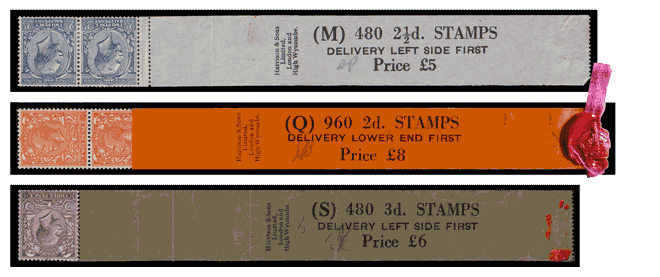
The printing contract changed from Harrison to Waterlow in 1924. At the same time, the watermark was changed from Royal Cypher to Block Cypher.
Waterlow was to print rolls by the continuous letterpress process established at Somerset House. As a result rolls would now have either 480 or 960 stamps and, since the cost of production would be less, the handling charge was to be reduced. However, the introduction of the new process was difficult and considerable numbers of joined rolls were produced.
The printing contract went back to Harrison in 1934 but, as the introduction of photogravure was also difficult, provisional printings were made by both Waterlow and Harrison in letterpress.
Printed by Waterlow
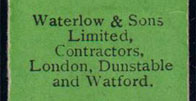
During the first months of Waterlow production there were difficulties with the new continuous printing machines, and it’s unclear how many of the twelve types of rolls were successfully produced. Only the rolls listed below have been recorded. The handling charge was initially 2d per 480 stamps.
| D | ½d | 960 | £2.0.4 | Lower End | Green/White | 20 |
| N | 1½d | 480 | £3.0.2 | Left Side | Buff | 12 csw |
| O | 1d | 480 | £2.0.2 | Left Side | Red/White | csw |
| P | ½d | 480 | £1.0.2 | Left Side | Green/White | 12 csw |
c: continuous csw: continuous sideways 12/20: strips
Rolls of 1,000 for top end delivery (ACJ) and rolls of 500 for lower end delivery (FHMS) had been discontinued in 1920. Rolls (WXYZ) printed by Waterlow are listed under Kermode.
Reduced Handling Charge
The handling charge was reduced from 2d to 1d per 480 stamps on 7 July 1924 and the full set of rolls was available, although some were still made from sheets. Rolls (NPT) were initially from sheets but soon changed to continuous printing. Existing rolls were amended in manuscript.
| B | 1d | 960 | £4.0.2 | Lower End | Red/White | c |
| D | ½d | 960 | £2.0.2 | Lower End | Green/White | c |
| E | 1d | 480 | £2.0.1 | Top End | Red/White | c |
| G | ½d | 480 | £1.0.1 | Top End | Green/White | c |
| K | 1½d | 960 | £6.0.2 | Lower End | Buff | c |
| L | 1½d | 480 | £3.0.1 | Top End | Buff | c |
| N | 1½d | 480 | £3.0.1 | Left Side | Buff | 12 csw |
| O | 1d | 480 | £2.0.1 | Left Side | Red/White | csw |
| P | ½d | 480 | £1.0.1 | Left Side | Green/White | 12 csw |
| Q | 2d | 960 | £8.0.2 | Lower End | Orange/White | 20 |
| R | 2d | 480 | £4.0.1 | Top End | Orange/White | 20 |
| T | 2d | 480 | £4.0.1 | Left Side | Orange/White | 12 csw |
c: continuous csw: continuous sideways 12/20: strips
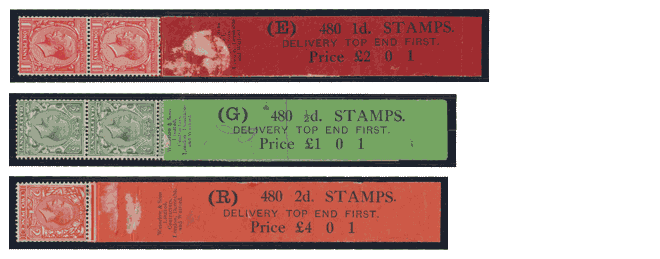
Continuously printed, watermark sideways (PONT):

This example of roll (N) is printed with £3.0.1 and uprated to £3.0.2 in pencil, possibly printed in anticipation of the reduced charge but issued before the reduction came into effect.

No Handling Charge
The handling charge was abolished on 1 Sept 1927. Existing rolls were amended in manuscript and Waterlow was instructed to produce new leaders. However, Waterlow had a considerable number of printed leaders still in sheet form (about 57½ reams — enough for around 300,000 rolls), and it was decided to use these by cancelling the shillings and pence with three black lines. Some of these cancelled leaders were in use for several years. By the time of the PUC issue in May 1929, only (K) and (P) rolls had been reprinted, PUC (BDEGLNO) were still using cancelled leaders, and it is likely that some continued in use into the 1930s.
| B | 1d | 960 | £4 | Lower End | Red/White | c |
| D | ½d | 960 | £2 | Lower End | Green/White | c |
| E | 1d | 480 | £2 | Top End | Red/White | c |
| G | ½d | 480 | £1 | Top End | Green/White | c |
| K | 1½d | 960 | £6.0.0 | Lower End | Buff | c |
| L | 1½d | 480 | £3.0.0 | Top End | Buff | c |
| N | 1½d | 480 | £3.0.0 | Left Side | Buff | csw |
| O | 1d | 480 | £2 | Left Side | Red/White | csw |
| P | ½d | 480 | £1 | Left Side | Green/White | csw |
| Q | 2d | 960 | £8 | Lower End | Orange/White | 20 |
| R | 2d | 480 | £4 | Top End | Orange/White | 20 |
| T | 2d | 480 | £4 | Left Side | Orange/White | csw |

New rolls were printed at face value with with the price shown in pounds only, except for rolls of 1½d (KLN) which showed zero shillings and zero pence.

Handling charge cancelled with three black lines.
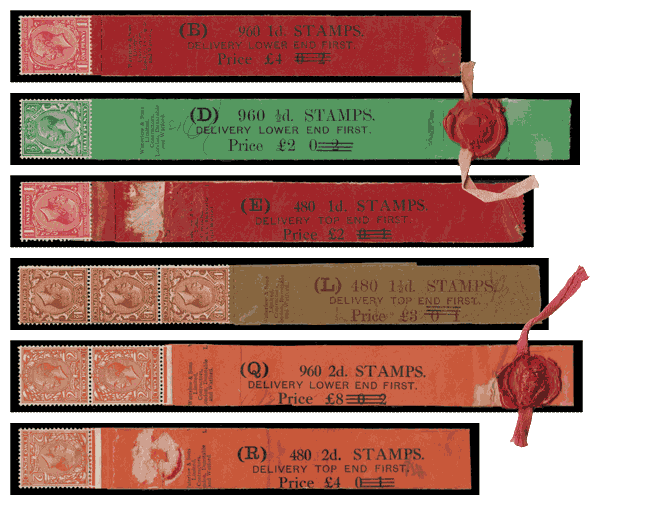
Continuously printed, watermark sideways (PONT):
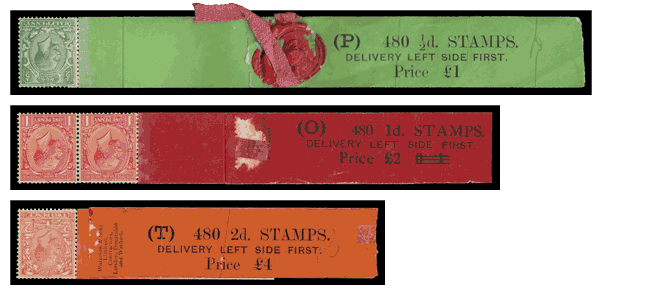
Higher Values
Under pressure from various affixing machine manufacturers, the Post Office agreed to make a trial supply of 2½d (F) rolls in September 1929 and these were available from November 1929. Several of these leaders are known on paper overprinted CANCELLED on the reverse.
| F | 2½d | 960 | £10 | Lower End | Pale Blue | 20 |

A supply of 3d (C) rolls were available from September 1932. The style of printing on (C) and (F) rolls is similar and neither has a printer’s imprint. Earlier rolls lettered (CF) had been discontinued in 1920.
| C | 3d | 960 | £12 | Lower End | Sage-Green | 20 |

Printed by Harrison
The printing contract changed back from Waterlow to Harrison on 1 Jan 1934 with the promise of upgrading the printing process from Letterpress to Photogravure, a faster and lower cost process using double sized cylinders instead of plates.
Harrison had to purchase another factory with new printing equipment and it took considerable time to get the new process up and running. Very few rolls were produced in photogravure during 1934, only some (EKL) rolls. Provisional printings were made by both Waterlow and Harrison in letterpress, although only Waterlow could print continuously in letterpress.
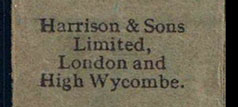
Harrison printed (MQS) rolls in letterpress (2d roll (Q) was still in use, but earlier rolls lettered (MS) had been discontinued in 1921). A Post Office Circular announced a limited number of new 2½d and 3d (MS) rolls were available in Feb 1935. These have the Harrison imprint, and no stop after “STAMPS”.
| M | 2½d | 480 | £5 | Left Side | Pale Blue | 12 |
| Q | 2d | 960 | £8 | Lower End | Orange/White | 20 |
| S | 3d | 480 | £6 | Left Side | Sage-Green | 12 |
